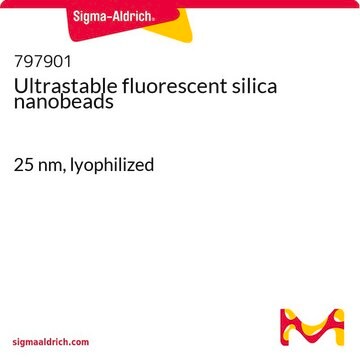637246
Silice
nanopowder (spherical, porous), 5-20 nm particle size (TEM), 99.5% trace metals basis
Synonyme(s) :
Dioxyde de silicium
About This Item
Produits recommandés
Pureté
99.5% trace metals basis
Forme
nanopowder (spherical, porous)
Superficie
590-690 m2/g , TEM
Taille des particules
5-20 nm (TEM)
Point d'ébullition
2230 °C (lit.)
Pf
>1600 °C (lit.)
Densité
2.2-2.6 g/mL at 25 °C
Masse volumique apparente
0.068 g/mL
Chaîne SMILES
O=[Si]=O
InChI
1S/O2Si/c1-3-2
Clé InChI
VYPSYNLAJGMNEJ-UHFFFAOYSA-N
Vous recherchez des produits similaires ? Visite Guide de comparaison des produits
Catégories apparentées
Description générale
Application
- Pickering emulsion polymerization using a silicon dioxide nanoparticle stabilizer to form molecularly imprinted polymers for steroid recognition.
- Mesoporous silica is used as a catalyst support in the preparation of multiwalled carbon nanotubes (MWCNTs).
- It is used as a ring opening of tetrahydrofuran-dimethanol to 1,2,6-hexanetriol.
- It maybe used to prepare silica/brominated poly(phenylene oxide) nanocomposites membranes for CO2 seperations.
- The composite scaffold of chitosan/chondroitin sulfate/nano-SiO2 was fabricated by lyophilization.
- Nanocomposites preparation of silica, single-wall carbon nanotubes, and graphite nanoplatelets in an epoxy matrix have been reported.6
- Dielectric spectroscopy study of the polystyrene/nanosilica model system has been studied.
- PMMA SiO2 nanocomposites were reported to be synthesized.
Code de la classe de stockage
11 - Combustible Solids
Classe de danger pour l'eau (WGK)
nwg
Point d'éclair (°F)
Not applicable
Point d'éclair (°C)
Not applicable
Équipement de protection individuelle
dust mask type N95 (US), Eyeshields, Gloves
Certificats d'analyse (COA)
Recherchez un Certificats d'analyse (COA) en saisissant le numéro de lot du produit. Les numéros de lot figurent sur l'étiquette du produit après les mots "Lot" ou "Batch".
Déjà en possession de ce produit ?
Retrouvez la documentation relative aux produits que vous avez récemment achetés dans la Bibliothèque de documents.
Les clients ont également consulté
Articles
Review the potential of self-assembled multilayer gate dielectric films fabricated from silane precursors for organic, inorganic, and transparent TFT and for TFT circuitry and OLED displays.
Hydrogen is one of the most important resources in providing food, fuel, and chemical products for our everyday life. Sustainable catalytic hydrogen production from bioethanol has gained significant attention in recent years due to globally diminishing fossil fuel supplies, which have necessitated the search for new chemical feedstocks.
Recent demand for electric and hybrid vehicles, coupled with a reduction in prices, has caused lithium-ion batteries (LIBs) to become an increasingly popular form of rechargeable battery technology.
Silica's versatility spans various industries, including biomedical applications.
Notre équipe de scientifiques dispose d'une expérience dans tous les secteurs de la recherche, notamment en sciences de la vie, science des matériaux, synthèse chimique, chromatographie, analyse et dans de nombreux autres domaines..
Contacter notre Service technique





